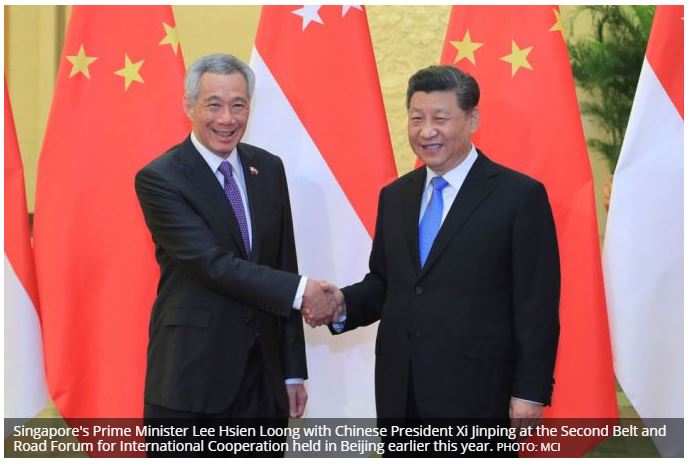Singapore has role in BRI’s investment into South-east Asia
THE Second Belt and Road Forum, held in Beijing in late April, marked the launch of BRI 2.0 and delivered a clear commitment to a more open, inclusive, sustainable and market-driven initiative.
This addresses concerns that had previously been raised over debt burdens connected with BRI (Belt and Road Initiative) projects, their transparency and their openness to non-Chinese participants.
Now we’re starting to see partner countries respond to this next phase of of the project, particularly in South-east Asia.
In May, Malaysia resumed the construction of East Coast Rail Link; in June, Indonesia requested that China set up a dedicated BRI fund following its offer for China to participate in 30 projects worth about US$91 billion.
And there’s more to come. Fitch Solutions recently estimated that US$255 billion of BRI projects are in the feasibility stage across the six largest Asean economies.
So as BRI 2.0 begins to re-energise across South-east Asia, what role can Singapore play in future?
Of course, Singapore will continue to pitch partnership with China in third-country project selection and advisory – a role it solidified through several BRI Memorandums of Understanding (MOUs) last year.
But it can also help China engage other countries with its commitment to transparent, sustainable and inclusive projects by helping to build relationships across governments, international business and people.
There are many ways Singapore can do this. Here are three:
- Facilitate the tapping of Singapore’s infrastructure agency and policy frameworks
China wants BRI-related projects to be more open and transparent. This will require building greater confidence and trust among recipient countries and project participants.
One way BRI can achieve this is to increase the frequency of deals that are arranged through third-party market cooperation rather than through direct country-to-country deals.
Given its world-class legal system and ecosystem of “cradle-to-grave” project advisory, financing and risk management capabilities, Singapore can help Chinese firms achieve this aim.
Singapore further extended its credentials in the past year through the launch of “Infrastructure Asia”, a new agency to link Singapore-based firms with regional project opportunities. It also launched the “Infrastructure Dispute-Management Protocol”, which aims to help manage project disputes.
But channelling projects through Singapore (or anywhere else) is easier said than done. It will require creating an environment and mechanism to entice Chinese firms to work within Singapore’s frameworks.
Infrastructure Asia is instrumental in linking and aligning Singapore-based firms with regional project opportunities. There is an opportunity to build a dedicated arm within the agency that is focused on helping Chinese companies identify, target and pitch projects across the region.
- Facilitate the drawing on Singapore’s business networks
China has stated that it wants BRI to be more inclusive, with the BRI Forum Joint Communique encouraging “the participation by enterprises from all countries … including small and medium-sized enterprises”.
The best way for international firms to crack BRI deals is by setting up strategic partnerships with both Chinese state-owned and privately owned enterprises. Again, Singapore can help deliver this.
Deloitte research found that nearly 90 per cent of Chinese state-owned enterprises (SOEs) have set up an arm that deals with overseas business, and many have turned to Singapore as a financial hub.
Through the business associations here – including Business China, the Singapore Chinese Chamber of Commerce and the Singapore Business Federation – there are regular formal engagement sessions with Chinese firms to understand business-to-business opportunities.
Similar to Infrastructure Asia, these forums need to ramp up the focus on attracting international engineering and construction firms to ensure these players understand the opportunities across the region, and where they can add value to future projects.
- Support the widening of BRI beyond energy and infrastructure
The BRI Joint Communique also stated that BRI “will strive to build high-quality, reliable, resilient and sustainable infrastructure…which will contribute to the sustainable development of participating countries”.
South-east Asia’s need for sustainable development is well known, and one area for BRI collaboration in this space could be the Singapore-led Asean Smart City Network (ASCN).
Agreed upon at the Asean Leaders summit last year, the ASCN is a platform for each of the region’s countries to share best practices, link member cities with private investment and secure funding from multilateral funding institutions.
The commercial opportunities are vast; McKinsey estimates the market for smart mobility technology within ASCN to be as large as US$70 billion, and opportunities to make the built environment smarter could be worth up to US$26 billion.
With more than 500 smart-city projects underway, China has the largest number of smart cities in the world and certainly the experience to make a meaningful contribution.
As the founding country and driver of the ASCN, Singapore can help ensure Chinese firms are plugged into the network and well positioned to align with the emerging projects.
Bringing it all together
BRI’s renewed commitment to transparency, sustainability and inclusiveness can have a profound and lasting impact on Asean.
Using Singapore’s infrastructure frameworks, credentials and reputation to channel more third-country projects through its ecosystem is one way it can help usher this new phase of the BRI.
But the strongest tool in Singapore’s arsenal is the array of infrastructure networks and forums that it has set up at home or oversees. Trust is built when deals are forged when industry players come together. It is this benefit that is often overlooked or glossed over.
BRI 2.0 will be no exception.
Through its various agencies and associations, Singapore has nurtured and built these crucial commercial interlockers. It is a powerful tool and one that governments, business and business associations should seek to leverage. Ultimately, success will be judged by what is executed in the Asean markets and by how Singapore is able to facilitate and support increased transaction flows under BRI 2.0.
- The writer is chairman of HSBC Bank (Singapore) and HSBC’s Asia-Pacific head for the Belt and Road Initiative
Source: https://www.businesstimes.com.sg/opinion/singapore-has-role-in-bris-investment-into-south-east-asia


 Thailand
Thailand




